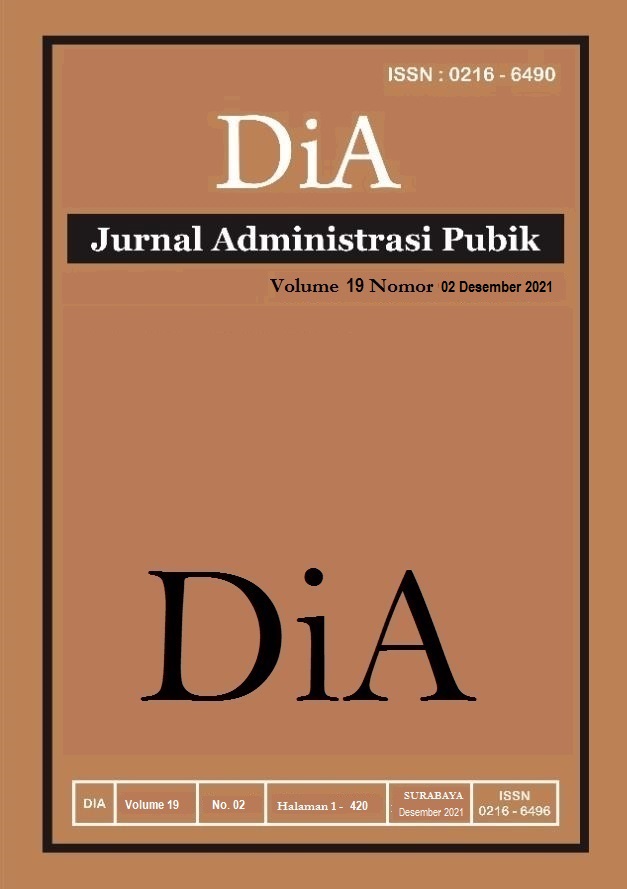LACK OF COLLABORATIVE GOVERNANCE IN BUILDING COMMUNITY DISASTER RESILIENCE
DOI:
https://doi.org/10.30996/dia.v19i2.5323Keywords:
colaborative governance, disaster management, community resilience, socio-ecological systemAbstract
Many deaths and victims caused by catastrophic natural hazard occurred in Indonesia has proven the weakness of government to create a community disaster resilience among society. Under this circumstance any efforts of government are expected to be solution to stop or at least reduce the nightmare of society when the disaster occurred. This paper elaborates the discussion about building community disaster resilience through collaborative governance performed by Banyuwangi local government in Indonesia. Furthermore, the discussion about community disaster resilience and collaborative governance will be tied up by institutional and socio-ecological context. Therefore, this paper will highlight the role of actors, collaborative process and organization performance rather than any technical attributes from disaster resilience. The finding of this study reveals that there are some inhibiting factors influencing collaboration among actor to build community disaster resilience. The failure to manage these factors has resulting lack of collaboration and lead to weak community resilience in Banyuwangi.
Downloads
References
Abhas, K.J., Todd, W.M., Zuzana, S.G. (2013). Building Urban Resilience: Principles, tools, and Practice, Washington DC: The World Bank.
Akamani, K., Wilson, P.I., and Hall, T.E. (2015). Barriers to Collaborative Forest Management and Implications for Building the Resilience of Forest-Dependent Communities in the Ashanti Region of Ghana. Journal of environmental management, Vol.151, pp 11-21.
Alexander, J.A., Maureen, E.C., Weiner, B.J. (1998). Governance in public private community health partnership: A survey of community network: SM demonstration sites. Nonprofit management & leadership, 8,231-232.
Anggriawan, T., Swanita, D. (2017) The strategy to make the quadruple helix (QHIS) works in ASEAN. Indonesian Association of Public Administration (IAPA) Conference Proceeding 2017, University of Airlangga.
Ansel,C., Gash, A. (2007). Collaborative Governance in Theory and Practice. Journal of Public Administration and Theory, 18.543-571.
Bae, Y., Joo, Y.M., Won, S.Y. (2016). Decentralization and Collaborative disaster governance: Evidence from South Korea. Journal of Habitat International, 52,40-56.
Basher, R., 2006. Global Early Warning System for natural hazards: systematic and people-centered. The Royal Society, 364, 2167-2182.
Clarke, M., Fanany, I., Kenny,S.(Eds). (2010). Post-Disaster Reconstruction: Lesson from Aceh. Earthscan, London.
Danar, O. R. (2016). Building Community Resilience in Tsunami Risk Area: Evidence from Pancer Hamlet, Banyuwangi District, Indonesia. PhD Dissertation, Tohoku University, Japan, (Retrieved in 16.09. 2017).
Danar, O.R., Pushpalal, D. (2014). Building community resilience: Conceptual framework and its application in post-tsunami resettlement, 18.489-496.
Denzin, N.K., Lincoln, Y.S. (2003). Introduction: The discipline and practice of qualitative research. In N.K. Denzin & Y.S. Lincoln (Eds.), The Landscape of qualitative research: Theories and Issues. London: Sage Publication.
Djelante, R. (2012). Adaptive and Integrated Disaster Resilience Framework. Macquarie University, Australia.
Edelenbos, J. (2005). Institutional implications of interactive governance: insight from Dutch practice Governance: An International Journal of Policy, Administration and Institutions, 18:111–34.
Folke, C., Carpenter, S.R., Elmqvist, T., Gunderson, L., Holling, C.S., and Walker, B. (2002). Resilience and sustainable development: building adaptive capacity in a world of transformations. Ambio 31, 437e440.
Guarnacci, U. (2012). Governance for sustainable reconstruction after disasters: Lesson from Nias, Indonesia. Journal of Environmental Development, 2.73 -85.
Gray, B. (1989). Collaborating: Finding common ground for multi-party problems. San Francisco, CA: Jossey-Bass.
Huxham, Chris. (2003). Theorizing collaboration practice. Public management reviews. 5:401-23.
Holling, C.S. (1973). Resilience and Stability of Ecological Systems. Annual Review of Ecology and Systematics, 4, 1-23.
Kapucu, N., Sadiq. (2016). Disaster Policies and Governance: Promoting Community Resilience. Journal of Politic and Governance, Vol. 4(4). 58-61.
Nguyen, D.N., Imamura, F., Iuchi, K. (2017). Public Private Collaboration for disaster risk management: A case study of hotels in Matsuhima, Japan. Journal of Tourist and Management, 61.129-140.
Pisano, U. (2012). Resilience and Sustainable Development: Theory of resilience, system thinking, and adaptive governance. European Sustainable Development Network, Austria.
Powell, E.T., Renner, M. (2003). Analyzing Qualitative Data. Wiconsin: University of Wiconsin.
Powell, W. W., Douglas,R.W., Kenneth, W.K., Jason, O, S. (2005). Network dynamics and field evolution: the growth of international collaboration in the life of sciences. American journal of Sociology, 110.1132-1205.
Seng, D.S.C. (2013). Tsunami resilience: Multi-level institutional arrangements, architectures and system of governance for disaster risk preparedness in Indonesia. Journal of environmental science and policy, 29. 57- 70.
Susskind, L., Cruickshank, J. (1987). Breaking the impasse: Consensual approaches to resolving public disputes. New York: Basic Book.
UNDP (United Nations Development Programme). (2009). Lesson Learned: disaster management legal reform, the Indonesian experience. Retrieved from http://www.undp.or.id/pubs/docs/Lessons%20Learned%20Disaster% 20Management%20Legal%20Reform.pdf. (01.09.2017).
UNDP (United Nations Development Programme). (2015). Strengthening Disaster Risk Governance: UNDP support during the HFA implementation period 2005-2015. UNDP: New York.
UNISDR (United Nations International Strategy for Disaster Reduction). (2008). Indigenous Knowledge for Disaster Risk Reduction: Good Practices and Lesson Learned from Experiences in the Asia-Pacific Region. UNISDR Asia and Pacific, Bangkok. Retrieved from http://www.preventionweb.net/files/3646_Indigenous Knowledge DRR.pdfS> (09.09.2017).
UNISDR (United Nations International Strategy for Disaster Reduction). Hyogo Framework for Action 2005–2015. Building the Resilience of Nations and Communities to Disasters. World Conference on Disaster Reduction (WCDR). Retrieved from http://www.unisdr.org/2005/wcdr/intergover/ official-doc/L-docs/Hyogo-framework-for-action-english.pdfS>. (27.09.2017).
UNISDR (United Nations International Strategy for Disaster Reduction). (2009). UNISDR Terminology on Disaster Risk Reduction. Geneva, UNISDR.
UN-OCHA Regional Office for Asia and the Pacific Bangkok. (2009). Risk Assessment and Mitigation Measures for Natural and Conflict-Related Hazard in Asia-Pacific.
Walsh, D.S., Madden, M., Purcell, S.M. (2016). Enhancing Community Resilience: Practical Resources in Addressing the Collaboration Gap. IRGC. EPFL: International Risk Governance Center. V29 Jul.2016.
Yin, R. K. (2003). Case Study Research: Design and Methods. Thousand Oaks, CA: Sage Publications.
Downloads
Published
How to Cite
Issue
Section
License
The DiA journal allows authors to retain the copyright of their papers without limitation. Authors may grant publishers non-exclusive publishing rights to publish articles. Granting first publishing rights to publishers also qualifies as unlimited copyright (because there are no restrictions imposed by publishers on author copyright).







